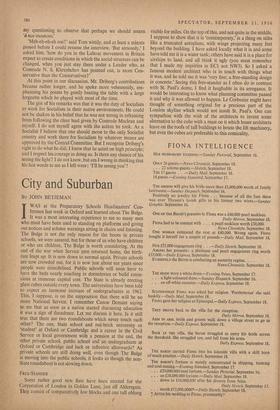City and Suburban
BY JOHN BETJEMAN WAS at the Preparatory Schools Headmasters' Con- / ference last week in Oxford and learned about The Bulge.
It was a most interesting experience to see so many men who must have been used to standing on platforms and giving out notices and solemn warnings sitting in chairs and listening. The Bulge is not the only reason for the boom in private schools, we were assured, but for those of us who have children or who are children, The Bulge is worth considering. At the end of the war when Service men returned home, the birth- rate leapt up. It is now down to normal again. Private schools are now crowded out, for it is now just about ten years 'since people were demobilised. Public schools will soon have to have the beds nearly touching in dormitories or build exten- sions at immense capital cost. The State is already erecting glass cubes outside every town. The universities have been told to expect an immense increase of undergraduates in 1962. This, I suppose, is on the supposition that there will be no more National Service. I remember Canon Demant saying tp me that as soon as a nation started discussing education it was a sign of decadence. Let .me discuss it here. Is it still true that there are two roundabouts which never touch each other? The one, State school and red-brick university or `student' at Oxford or Cambridge and a career in the Civil Service or local government with a pension at the end, the other private school, public school and an undergraduate at Oxford or Cambridge and luck or influence afterwards? As private schools are still doing well, even though The Bulge is moving into the public schools, it looks as though the non- State roundabout is not slowing down.
FREE-STANDER Some rather good new flats have been erected for the Corporation of London in Golden Lane, just off Aldersgate. They consist of comparatively low blocks and one tall oblong visible for miles. On the top of this, and not quite in the middle. I suppose to show that it is 'contemporary,' is a thing on stilts like a truncated aeroplane, with wings projecting many feet beyond the building. I have asked locally what it is and some, have told me it is a water tank; others have said it is a place for airships to land, and all think it ugly (you must remember that I made my inquiries in EC1 not NW3). So I asked a famous modern architect who is in touch with, things what it was, and he told me it was `very fine; a free-standing design in concrete.' Seeing this free-stander as I often do in contrast with St. Paul's dome, I find it laughable in its arrogance. It would be interesting to know what planning committee passed it and why it was allowed to happen. Le Corbusier might have thought of something original for a precious part of the London skyline which would not insult St. Paul's. One can sympathise with the wish of the architects to invent some alternative to the cube with a mast on it which lesser architects leave on the roofs of tall buildings to house the lift machinery, but even the cubes are preferable to this comicality.


































 Previous page
Previous page